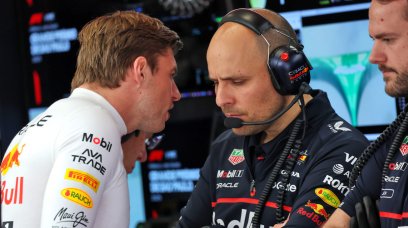Four years on from its introduction into F1, Ferrari's Laurent Mekies has been recounting the efforts it took to bring the Halo to Formula 1. Mekies – who holds the role of Racing Director for the Scuderia – was one of those involved in presenting the data behind the device ahead of it being brought into effect for the 2018 season. While the Halo has earned praise in the years since for its role in protecting drivers from serious accidents, there was not universal support for it at the time, as Mekies has recalled in an exclusive interview with RacingNews365.com .
Mekies felt that "everybody" was against Halo
Looking back now, Mekies admits that there were some concerns about bringing a cockpit protection system to F1. "Everybody was against us," Mekies said. "Every single person was against us. That's how it started. Because of something very fair, because of the aesthetic – [people thought] the aesthetic was unpleasant. "There were these false feelings of high-enough safety, so [people asked], 'Why are you trying to push the boundaries?'" Despite the protests, boundaries continued to be pushed in the process of developing the Halo. "[We pushed the boundaries] because we wanted to be productive, we wanted to go to the next step," Mekies continued.
Mekies credits Todt with crucial role in bringing Halo
Mekies credits the influence of former FIA President Jean Todt in terms of pushing for the Halo to be introduced and encouraging the team behind it to "think outside of the box". "The FIA have looked at head protective systems back from 2009, after the [Henry] Surtees accident," Mekies explained, referencing the fatal Formula 2 crash involving the son of John Surtees. "So we took that work back, and and we eventually – with the help of the teams, with the help of all the groups there – [turned] it into what you know as being the Halo today. That's what it was. "But ultimately, it comes from the top. It comes from the incredibly strong push from Jean Todt. It comes from the fact that – I am biased now, because I'm here, but you can look back at the other recordings and public elements – the only support we got at the time was from Ferrari. "[They] were basically saying, 'Do what you need to do, it's safety first'." Following the passing of Jules Bianchi in 2015, Mekies says that more drivers started to get on board with the plans for the Halo, including Lewis Hamilton, Daniel Ricciardo and Felipe Massa.
Other safety pushes in Formula 1
Along with the Halo, there have been various other safety developments pushed for in Formula 1, and Mekies has singled out some that he feels were particularly important, such as the high-speed camera that assists with understanding accidents. "Why is the high-speed camera [important]? Because you could start understanding certain dynamics in crashes that you had no idea of before," the engineer explained. "And that helps you design the cockpit, that helps you design the headrest, that helps you design the belt, that helps you [in] understanding how to use the HANS [device]. "So now we have it everywhere, in Formula 1, Formula E and in a few other [categories]." Mekies is pleased to see the knock-on effect that safety innovations in F1 have had on other categories of motorsport. "I think the biggest achievement, besides the Halo, was the cascading of what we are doing in F1 to the other categories," he added. "Again, that was Jean's huge push. He didn't want to take any compromises. "If you look now, we have the Halo in Formula 4, but that was the same for everything else we were doing – for the crash test, for the fire suits, for everything."
Most read







